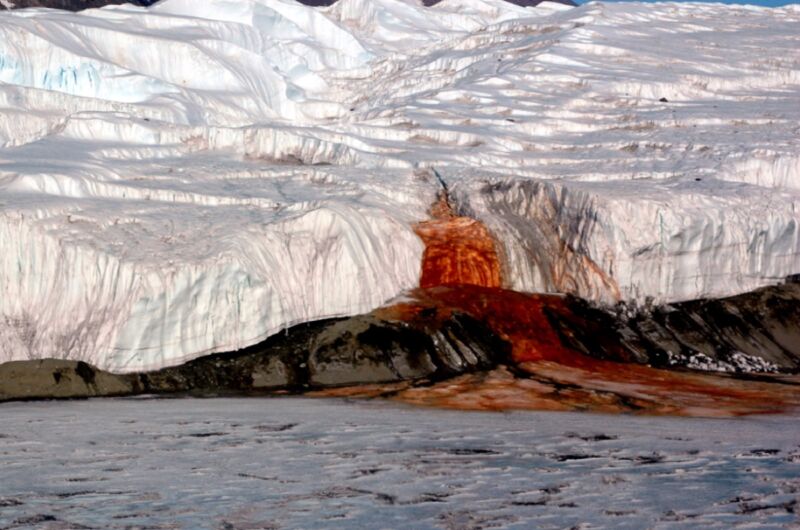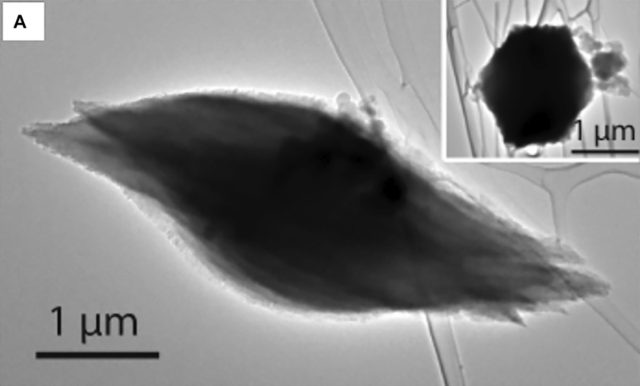The culprit: tiny non-crystalline nanospheres rich in iron, silica, calcium, aluminum, etc.

Blood Falls seeps from the end of the Taylor Glacier into Lake Bonney. Scientists believe a buried saltwater
reservoir is partly responsible for the discolouration, which is a form of reduced iron.
NSF/Peter Rejcek/Public domain
In 1911, an Australian geologist named Thomas Griffith Taylor was exploring a valley in Antarctica when he stumbled upon a strange waterfall. The meltwater flowing from beneath the glacier that now bears Taylor's name turns a deep red upon coming into contact with the air, earning the site the moniker "Blood Falls." Various hypotheses have been proposed over the last century to explain the strange phenomenon. A team of scientists now thinks they've finally found the answer: tiny nanospheres rich in iron, silica, calcium, aluminum, and sodium, among other elements.
But why has solving this mystery taken more than a century? It seems the nanospheres are amorphous materials, meaning they lack a crystalline structure and hence eluded prior analytical methods looking for minerals because they are not, technically, minerals, according to a recent paper published in the journal Frontiers in Astronomy and Space Science. That might seem like an odd choice of journal for this study, but the Blood Falls at Taylor Glacier is a so-called "analogue" site for astrobiologists and planetary scientists keen to learn more about how life might evolve and thrive in similar inhospitable environments elsewhere in the universe.
"With the advent of the Mars Rover missions, there was an interest in trying to analyze the solids that came out of the waters of Blood Falls as if it was a Martian landing site," said co-author Ken Livi of Johns Hopkins University. "What would happen if a Mars Rover landed in Antarctica? Would it be able to determine what was causing the Blood Falls to be red? It's a fascinating question and one that several researchers were considering."
Those researchers include his co-author, Jill Mikucki of the University of Tennessee, a microbiologist who has been studying the Taylor Glacier and its distinctive waterfall for years. She and her team previously studied samples taken from the site using a suite of techniques also used by NASA for its Mars missions to explore that planet's surface. Those include Mossbauer spectroscopy used by Spirit and Opportunity; visible to near-infrared spectroscopy (VNIR); mid-far infrared spectroscopy used on the Mars Global Surveyor and Mars Odyssey; in situ x-ray diffraction (XRD) used by Curiosity; and Raman spectroscopy used on Perseverance.
In 2009, Mikucki's team detected living organisms—17 different types of microbes—in the lake beneath the glacier, likely able to survive the dark, oxygen-free waters by drawing energy from sulfur and iron. In 2014, the team used a special probe called IceMole to directly sample the salty water flowing into the Blood Falls. Mikuchi's team mapped all the glaciers, caves, and rivers to determine that the water originates from a briny subglacial reservoir rich in minerals, which accumulated in the ice as it moved across the rocks. And they found that the brine was very cold ( minus 7° Celsius, 19° F), rich in iron, with 8 percent sodium chloride. Plus, they were able to isolate a salt-water-loving bacteria that thrives in the cold, anaerobic environment, as well as two other types of bacteria.

TEM results for one of the samples shows aragonite in the “seed” habit. Inset: the cross-section profile.
E.C. Sklute et al., 2023
But they were still unable to determine the cause of the Blood Falls' red hues. Early Arctic explorers initially thought red algae was to blame, while later researchers suggested iron oxides. (Iron in some form is indeed present in the original sample taken from Blood Falls, per the authors.) The discharge anecdotally appears to deepen in color over the course of the summer, and historical accounts describe a yellowish-orange color to the outflow fan that has been attributed to goethite or magnetite. A 1965 study found aragonite, quartz, and feldspar in the glacier discharge, along with small amounts of magnetite and mica, but no goethite.
For this latest study, Mikuchi's team used samples collected from the Blood Falls "ice cone" with sterile scoops, once in November 2006 and twice in mid and late November 2016. They then analyzed the samples with a suite of different methods, including XRD, Fourier-transform infrared spectroscopy, Raman spectroscopy, VNIR, scanning electron microscopy, and transmission electron microscopy (TEM), among others. "Each technique delivers a piece of the puzzle," the authors wrote, and that piece might be ruling out several previously suggested minerals.
This latest analysis confirmed the previously detected presence of aragonite, quartz, and feldspar, as well as calcite and clay minerals. However, it contradicted the earlier claim that the blood-red color comes from iron oxides; only trace amounts were found. Rather, the TEM analysis revealed the presence of the iron-rich nanospheres. "In order to be a mineral, atoms must be arranged in a very specific, crystalline, structure," said Livi. "These nanospheres aren't crystalline, so the methods previously used to examine the solids did not detect them."
The iron in the nanospheres oxidizes to turn the water flowing to the Blood Falls that distinctive red hue. The authors suggest that iron might not be acting alone. Other elements present, like chlorine, magnesium, and sodium, may contribute to the yellowish-orange colors observed in the outflow fan. And the fact that TEM detected components that had eluded prior attempts points to the need for more complementary approaches going forward, per the authors.
"Our work has revealed that the analysis conducted by rover vehicles is incomplete in determining the true nature of environmental materials on planet surfaces," said Livi. "This is especially true for colder planets like Mars, where the materials formed may be nanosized and non-crystalline. Consequently, our methods for identifying these materials are inadequate. To truly understand the nature of rocky planets' surfaces, a transmission electron microscope would be necessary, but it is currently not feasible to place one on Mars."
DOI: Frontiers in Astronomy and Space Science, 2023. 10.3389/fspas.2022.843174 (About DOIs).
Source




3175x175(CURRENT).thumb.jpg.b05acc060982b36f5891ba728e6d953c.jpg)


Recommended Comments
There are no comments to display.
Join the conversation
You can post now and register later. If you have an account, sign in now to post with your account.
Note: Your post will require moderator approval before it will be visible.